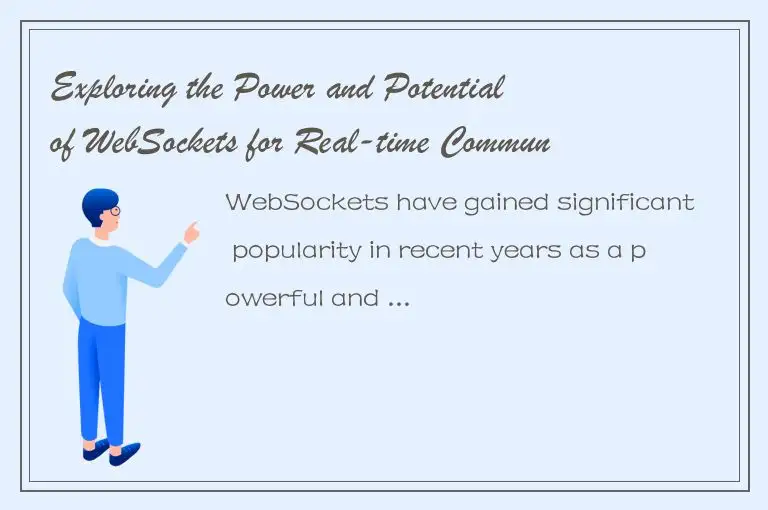WebSockets have gained significant popularity in recent years as a powerful and reliable technology for real-time communication. It enables bi-directional communication between a browser and a server, allowing web applications to deliver real-time updates to users without the need for constant page refreshes. In this article, we will explore the power and potential of WebSockets for real-time communication, and how it is transforming the way web applications operate.

Introduction to WebSockets
WebSockets are a protocol used for bi-directional, real-time communication between a web browser and a server. It uses a single persistent connection that can be used for multiple requests and responses between the client and server. This approach differs from the traditional HTTP protocol, which uses a request-response model, where each request is processed independently. With WebSockets, the server can initiate a message to the client at any time and vice versa. This seamless communication between the client and server is what makes WebSockets so powerful.
WebSockets can be used for a variety of real-time communication scenarios, including multiplayer games, chat applications, dashboards, stock tickers, and more. It provides a reliable and fast way to push updates to clients without the need for polling or long-polling techniques. Instead, the server can send updates as soon as they are available, leading to near-instantaneous updates for end-users.
The WebSocket API
The WebSocket API provides a simple and standardized way to create a WebSocket connection between a client and server. It includes two endpoints, one on the client-side and the other on the server-side, with a protocol in between. The API provides methods for opening and closing the connection, sending messages, and handling events. The API also includes support for binary messages, allowing for more efficient data transfer.
To create a WebSocket connection, the client uses the WebSocket constructor function, passing in the URL of the WebSocket server endpoint. The server can be implemented in any language, as long as it provides a WebSocket server implementation. Once the connection is established, the client can send messages to the server using the send() method, while the server can send messages to the client using the send() method on the WebSocket object.
WebSockets in Action
Let's take an example to see WebSockets in action. Suppose we want to build a real-time chat application using WebSockets. Here's how we can do it:
1. Set up a WebSocket server on the backend using a language like Python or Node.js.
2. Create a WebSocket connection on the client-side using the WebSocket API in JavaScript.
3. When the user sends a message, send it to the server using the send() method on the WebSocket object.
4. When the server receives a message, broadcast it to all other connected clients.
5. When a client receives a message, display it on the screen.
Now, with a WebSocket connection in place, messages can be sent and received in real-time, allowing for a more interactive and engaging chat experience.
WebSockets vs. HTTP Long-polling
Long-polling is a common technique used for real-time communication in web applications. It involves the client sending a request to the server, and the server holding the request open until new data is available, or a timeout occurs. When new data is available, the server responds, and the client immediately sends a new request to the server.
Long-polling is useful, but it has some significant drawbacks. Each request creates a new connection to the server, leading to high overhead and latency. In contrast, WebSockets use a single persistent connection, reducing the overhead and minimizing latency. WebSockets are more efficient than long-polling, making it a better choice for real-time communication scenarios.
Potential of WebSockets
WebSockets have enabled web developers to build high-performance real-time applications with ease. It has opened up new possibilities for interactive and engaging applications, where real-time data delivery is critical. Here are some potential use cases of WebSockets.
1. Multiplayer games: WebSocket technology enables real-time communication between players, enabling them to interact with each other in real-time.
2. Chat applications: WebSockets enable real-time messaging, allowing users to send and receive messages instantly.
3. Financial applications: Stock tickers and trading platforms rely on real-time data and can benefit from WebSocket technology for real-time updates.
4. Collaborative applications: Tools like Google Docs require real-time collaboration, making WebSockets an ideal technology for enabling real-time interaction.
Conclusion
WebSockets are a powerful and reliable technology for real-time communication, enabling web applications to deliver near-instant updates to users. It has opened up new possibilities for interactive and engaging applications, where real-time data delivery is critical. With WebSockets, developers can build high-performance real-time applications with ease, transforming the way web applications operate.




 QQ客服专员
QQ客服专员 电话客服专员
电话客服专员